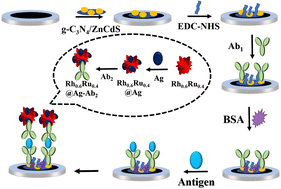ZnCdS enhanced g-C3N4 electrochemiluminescence behavior based on Rh0.6Ru0.4@Ag quenching for neuron-specific enolase detection†
Abstract
A novel quenching electrochemiluminescence (ECL) immunosensor for the trace detection of neuron-specific enolase (NSE) was developed. Doping CdS with Zn2+ to obtain ZnCdS not only significantly improves the original properties of CdS, but also can be loaded onto the surface of g-C3N4 to form a special complex structure, which effectively improves the ECL performance of g-C3N4. Rh0.6Ru0.4 alloys with flower-like structures were prepared by simple hydrothermal synthesis, with excellent electrical conductivity and catalytic performance. Due to its special flower-like structure with a large specific surface area, Ag nanoparticles can be uniformly loaded on its surface to form Rh0.6Ru0.4@Ag composites. Through spectral comparison, it was found that Rh0.6Ru0.4@Ag has strong UV-vis absorption in the ECL emission wavelength range of g-C3N4, which can generate resonance energy transfer, thereby effectively quenching the ECL signal. The immunosensor has a wide detection range with a detection limit of 16 fg mL−1 (S/N = 3), good stability and biocompatibility, and has great potential in clinical application.



 Please wait while we load your content...
Please wait while we load your content...